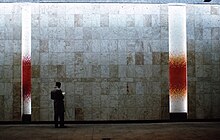Op art
However, the antecedents of op art, in terms of graphic effects and concern for exotic optical illusions, can be traced back to Neo-Impressionism, Cubism, Futurism, Constructivism and Dada.For instance, Victor Vasarely's painting Zebras (1938) is made up entirely of curvilinear black and white stripes not contained by contour lines.[7] Op artists thus managed to exploit various phenomena," writes Popper, "the after-image and consecutive movement; line interference; the effect of dazzle; ambiguous figures and reversible perspective; successive colour contrasts and chromatic vibration; and in three-dimensional works different viewpoints and the superimposition of elements in space.[2]In 1955, for the exhibition Mouvements at the Denise René gallery in Paris, Victor Vasarely and Pontus Hulten promoted in their "Yellow manifesto" some new kinetic expressions based on optical and luminous phenomenon as well as painting illusionism.Some members of the group Nouvelle tendance (1961–1965) in Europe also were engaged in op art as Almir Mavignier and Gerhard von Graevenitz, mainly with their serigraphics.[9] In 1965, between February 23 and April 25, an exhibition called The Responsive Eye, created by William C. Seitz, was held at the Museum of Modern Art in New York City and toured to St. Louis, Seattle, Pasadena, and Baltimore.[10][11] The works shown were wide-ranging, encompassing the minimalism of Frank Stella and Ellsworth Kelly, the smooth plasticity of Alexander Liberman, the collaborative efforts of the Anonima group, alongside the well-known Wojciech Fangor, Victor Vasarely, Julian Stanczak, Richard Anuszkiewicz, Wen-Ying Tsai, Bridget Riley and Getulio Alviani.[citation needed] Beginning in 1965 Bridget Riley began to produce color-based op art;[15] however, other artists, such as Julian Stanczak and Richard Anuszkiewicz, were always interested in making color the primary focus of their work.





pop artplop artOOPArtOOPARTS (disambiguation)Operational level of warBridget Rileyvisual artoptical illusionsFrancis PicabiaJesús SotoIllusionismNeo-ImpressionismCubismFuturismConstructivismDivisionistsluminosityLászló Moholy-NagyBauhausJulian StanczakMartha Jackson GalleryVictor VasarelycurvilinearJohn McHaleThis Is TomorrowInstitute of Contemporary ArtsMartin GardnerMathematical Games columnFranco Grignanikinetic artoptical illusionWojciech FangorStefan KnappconstructivistWalter Gropiustrompe-l'œilanamorphosisGestalt theorypsychophysiologyChicagoBlack Mountain CollegeAsheville, North CarolinaJosef AlbersDenise RenéPontus HultenMuseum für GestaltungZürichYacov AgamCarlos Cruz-DiezJesús Rafael SotoGregorio VardanegaNicolas SchöfferGroupe de Recherche d'Art VisuelFrançois MorelletJulio Le ParcFrancisco SobrinoYvaralVera MolnárlabyrinthsNouvelle tendanceGerhard von GraevenitzArnold Alfred SchmidtTerrain GalleryMuseum of Modern ArtFrank StellaEllsworth KellyAlexander LibermanAnonima groupRichard AnuszkiewiczWen-Ying TsaiGetulio AlvianiBrian de Palmafigure-groundblack and whitegrisailleGoetheTheory of ColoursFire and Water FountainYaacov AgamDizengoff Squareabstract expressionismcolor field paintingList of op artistsDivisionismBinakaelChubb illusionCornsweet illusionImpossible objectLilac chaserM. C. EscherMach bandsMultistable perceptionPattern glarePerceptionPeripheral drift illusionSame color illusionZero (art)Gordon HyattMike WallaceFrank PopperEdna AndradeEdwin MieczkowskiAndrzej NowackiGrazia VariscoJean-Pierre YvaralColor theoryFigure–groundHard-edge paintingGeometric abstractionConcrete artDe StijlMinimalismSuprematismAfterimageAmbigramAmbiguous imageAmes roomAutostereogramBarberpoleBezoldCafé wallChecker shadowCornsweetDelboeufEbbinghausEhrenstein